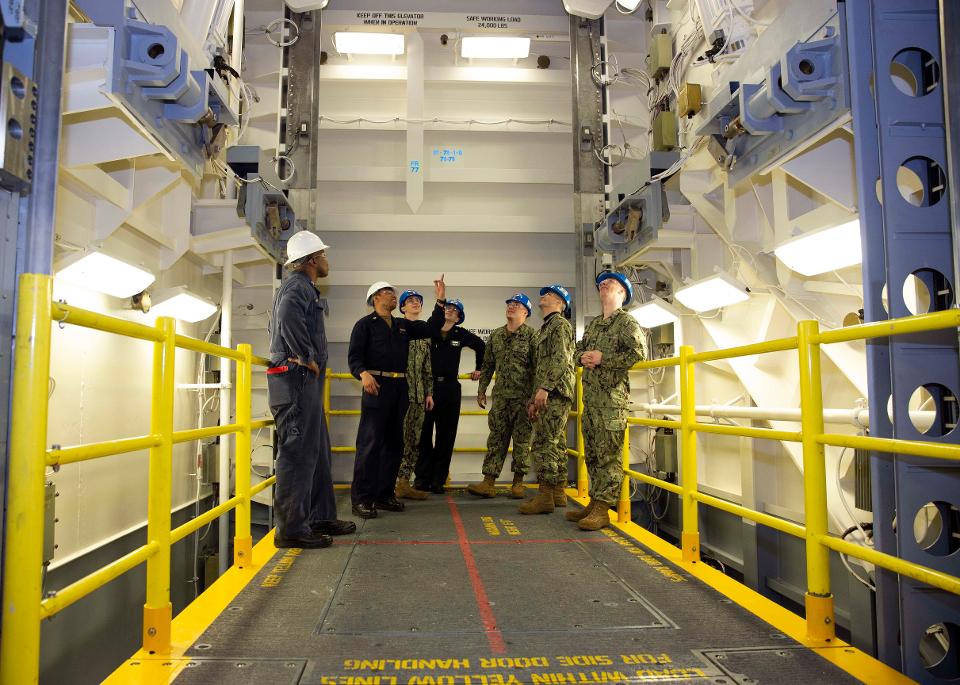The Most Expensive Ship In The World Is Broken. The U.S. Navy Secretary Should Be Held Accountable.
Secretary of the Navy Richard V. Spencer bet his job that the USS Ford would work when it left the ... [+]
Getty Images
Later this month, tugs will pull the most expensive ship ever built in the world, the USS
Gerald R. Ford (
CVN 78), away from the
Huntington Ingalls Industries shipyard in Virginia. But America’s brand-new, $13 billion aircraft carrier will emerge from a 15-month refit, or “post-shakedown availability,” broken and unable to fight. This is unacceptable, and it is high time for the Secretary of the Navy,
Richard V. Spencer, to hold his service accountable.
But he can’t.
At the USS
Ford, the extent of America’s massive systems engineering failure is impossible to understate. The aircraft carrier does not work. As of October 9, only
two of eleven advanced weapons elevators actually function, making it impossible for the carrier to safely receive and store weapons. Compounding the problem, the Secretary of the Navy made a high-profile bet with President Donald J. Trump, that, if the USS
Ford left the shipyard without functional elevators, the President
could fire him.
So rather than search for accountability and solutions within the Navy he leads, it is now time for Mr. Spencer to do the right thing and resign, letting somebody else find the faults and fix them.
If the Secretary of the Navy counts upon Presidential inaction, staying on after the broken USS
Ford leaves the shipyard, he will plunge the U.S. Navy into a full-fledged accountability crisis. If that happens, Mr. Spencer deserves a peremptory summons to the Oval Office and a swiftly-delivered “
You’re Fired” moment before assembled White House press cameras. And then, as Secretary Spencer takes his long and lonely limo drive to the airport, the U.S. Navy needs to sit down and determine why the organization failed such a promising Service Secretary.
Only two Advanced Weapons Elevators actually work. Nine elevators that serve lower compartments are ... [+]
US Navy
The Navy Is Not Transmitting Information Up The Chain:
A troubling unwillingness to transmit troubling data up the chain of command likely led Secretary of the Navy Richard V. Spencer to fatally compromise his tenure.
In December 2018, the Secretary of the Navy, after hearing President Donald Trump complain about the non-functional elevators aboard the troubled USS
Gerald R. Ford (CVN-78) aircraft carrier, made an ill-advised wager with the President. According to
USNI News, the Secretary Spencer said, “I asked him to stick his hand out; he stuck his hand out. I said, let’s do this like corporate America. I shook his hand and said, the elevators will be ready to go when she pulls out or you can fire me.”
To observers, this was a foolish gamble by an inexperienced bureaucrat. But, at some level, Secretary Spencer had to know what he was doing. He has, after all, a reputation for being a
sophisticated and sober businessman. He served in the Marine Corps, and then he went to corporate America, working at Goldman Sachs, Bear Stearns, Merrill Lynch and several other firms. That sort of bio suggests the Secretary of the Navy is able to collect data and make rational decisions. It hints that the Navy Secretary’s unfortunate bet would never have happened unless someone, somewhere in the Navy, indicated that the USS
Ford’s elevators were making good progress.
They weren’t.
At the time Secretary Spencer made his bet, even casual shipyard observers knew that the likely problems with the USS
Ford’s structural flexing and the vessel’s dysfunctional elevators were far larger and more challenging than portrayed. And now, after fifteen months in the shipyard, the Navy is pulling the ship out of the yard before any of the nine lower ammunition-carrying elevators—critical elevators that are needed to stow the ammunition required to make the ship battle-ready—are working. Sources say that one, maybe two elevators are nearing completion. But then, even if the advanced electromagnetic elevators work, the USS
Ford must go through a
shock trial, where the ship is jolted by a series of explosive charges near the hull. The rickety elevators–along with several other critical subsystems that require tight tolerances to operate correctly–are unlikely to survive intact.
The scope of the systems engineering failure is enormous. Upper stage advanced weapons elevator Number 1
was accepted in December 2018, and Upper stage advanced weapons elevator Number 3
was accepted in early 2019. Despite comforting affirmations, a slew of wrong predictions,
elevator tiger teams, construction of an
on-land prototype, and an on-land “
digital twin”, no other elevator has evidently been fixed while the USS
Ford has been in the shipyard. And it is unlikely they will be fixed without another full-scale refit.
The Secretary of the Navy is not alone in trafficking over-optimistic predictions about the USS
Ford. Eleven months ago, Assistant Secretary of the Navy for Research, Development and Acquisition
James Geurts, when the Senate asked him for a target date on the elevators,
testified, “we will get through all of the production and much of the testing.” And yet here we are, in October 2019, with only two functional elevators.
It is an accountability nightmare. How did these senior leaders–the top civilian leaders of the Navy–get their assessments so wrong?
Even though nobody has been fired—yet—the bet has compromised the Secretary of the Navy’s effectiveness, limiting his ability to sell the Navy to the American People. It is a tragedy. Behind the scenes, the Secretary is well-liked, earning the respect of partners in Congress, industry and beyond. But the un-managed fracas around Spencer’s ill-made bet has made the Navy Secretary a public caricature. He appears in public only to give a canned motivational speech, take softball questions from friendly moderators, and then retreat to his Pentagon office, surrounded by a skeleton crew of staff who seem more eager to fret over his public image than to answer tough questions about the state of the force.
Is this any way to run a Navy? Is this how corporate America does it—isolated, ineffective, over-budget and completely unaccountable? If so, the venerable titans of American industry and the American Navy are weeping in embarrassment.
Let’s Peel The Onion: Accountability Is Lacking:
Certainly, nobody wants to bring bad news to the boss. But in battle, prompt transmission of valid information is a matter of life and death. The choices can be stark. Leaders need good information to act upon or sailors will perish.
Despite regular exhortations to “train as you fight and fight as you train”, the naval enterprise struggles to bring bad news to the higher levels in the chain of command. It is a habit that perpetuates something of a complacent “not my problem” or career-protecting sluggishness in the face of avoidable disaster.
It is a habit the U.S. Navy can no longer afford.
Every naval stakeholder knows that sustained refusal to confront discomforting news has devastating consequences in terms of sunk costs, sunken ships and, in time, dead sailors. But, somehow, again and again, critical information is not getting through to leadership. This has to stop.
Transmitting valid but troubling data and acting decisively on that information is not easy. But making tough calls is the essence of public service and military command, and it is what any Navy is built to do.


